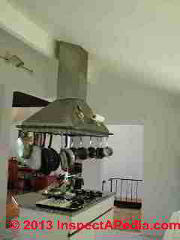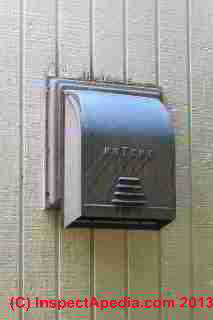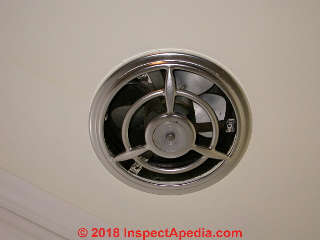 Kitchen Exhaust Vent Fan FAQs
Kitchen Exhaust Vent Fan FAQs
Q&A on Best Practices for kitchen exhaust fans or kitchen vents
- POST a QUESTION or COMMENT about kitchen ventilation system design, installation, choices, and best practices, Q&A on venting microwave appliances.
Q&A about inspecting, installing & specifying or repairing kitchen exhaust vent fans.
This article series explains kitchen vent fan types, ventilation rate, installation specifications, and noise ratings.
InspectAPedia tolerates no conflicts of interest. We have no relationship with advertisers, products, or services discussed at this website.
- Daniel Friedman, Publisher/Editor/Author - See WHO ARE WE?
Kitchen Ventilation Fan & Hood FAQs

These questions & answers about kitchen ventilation, vent fans or exhaust fans were posted originally
at KITCHEN VENTILATION DESIGN - please also read the advice and design tips given there.
On 2018-08-28 by (mod) -
Sounds reasonable to me, Ann.
On 2018-08-28 by Anonymous
Thanks for your reply. I looked at codes for Maryland, where I live, and your posting for VA above as well, and didn't see it. It sounds like if I keep the fan and area clean of grease, it will be alright. I'll go with your cleaning advice, thanks!
On 2018-08-28 by (mod) -
Thanks for an interesting question, Ann.
I was not able to find a standard or code that warns that a higher CFM residential kitchen exhaust fan is a grease fire hazard per-se.
The very first fire-safety concern with kitchen exhaust vent fans is not the fan age, location or size in CFM, but rather grease contamination. If an old 1950s (or any other) kitchen exhaust fan is greasy it is inviting a fire. If you haven't done so you should dis-assemble and clean the grease from the entire fan.
It's a good practice to inspect and clean a residential kitchen exhaust fan once a year.
NFPA 11.6.1 –“Upon inspection, if the exhaust system is found to be contaminated with deposits from grease-laden vapors, the contaminated portions of the exhaust system shall be cleaned by a properly trained, qualified, and certified company or person(s) acceptable to the authority having jurisdiction.”
NFPA 11.6.2 –“Hoods, grease removal devices, fans, ducts, and other appurtenances shall be cleaned to remove combustible contaminants prior to surfaces becoming heavily contaminated with grease or oily sludge.”
On 2018-08-28 by Ann G
Hello. I am weighing the benefits and drawbacks of keeping a 1950s Nutone kitchen fan in my kitchen. It is a 10 inch fan that is mounted vertically through the wall with a cover on the outside, and is 50 inches above the stovetop (there is a window between the stove and the fan).
I don't know the CFM rating for it, but it moves a ton of air quickly (modern Nutone/Broan 10 inch fans say 560 CFM). However, is this a fire hazard with grease?
On 2018-08-24 by Chuck
Can a vertically mounted through wall exhaust fan be placed to the side of a gas range with the fan at an elevation just above the burners, similar to what was done in older homes.
On 2018-03-23 by (mod) -
Catherine,
Using the U.S. IMC, window-clearance distances are not given explicitly in words that answer you clearly. Instead we have this more-engineering like statement
The average velocity at the face of the access ports or windows in the gas cabinet shall not be less than 200 feet per minute (1.02 m/s) with a minimum velocity of 150 feet per minute (0.76 m/s) at any point at the access port or window.
Running an exhaust vent through a beam could present two serious problems:
1. you are cutting a very large opening in a structural member, potentially weakening it significantly, risking structrual damage or worse,
2. for a vent conducting grease or greasy exhaust your vent could violate required fire clearance distances.
I've added vent code citations including for New York City in the bottom of the article above. You may need to clear your browser cache and it could take an hour or two for the added detail to appear on your local server.
On 2018-03-23 by Catherine Kokinchak
I am searching for information on building codes for an overhead range exhaust vent, I would like to know the clearance this vent must be from any building opening such as a window or door? I would like to know if it can be mounted thru a structural beam or should it go thru the side wall of the building non structural, are there codes for this in New York? I am have trouble locating structural building codes. catkokinchak@aol.com
On 2017-02-26 by (mod) -
Perhaps if you can keep the total run short enough and minimize the number of elbows and bends. The problems are pretty obvious: blockage, difficulty in cleaning, fire hazards. Check with the manufacturer of your range hood on allowable distances and bends.
On 2017-02-26 by Evelyn
The roof space directly above where our range hood would vent is in the valley next to a mansard roof. Venting through the soffit is not desireable. Can we still vent through another location in the roof?
On 2016-12-23 by (mod) -
Eric:
Good point. Indeed I too have dealt with cold drafts blowing back into a building through a kitchen exhaust. The exhaust should ABSOLUTELY NOT be connected to a building chimney. That would be improper, unsafe, and risks fire or CO poisoning. More likely the exhaust hood vents outside through its own duct through a wall, floor, or ceiling.
A good-functioning exhaust fan system includes a baffle on the outdoors surface that closes when the fan is off to prevent backdrafting. But even then some of those leak.
First confirm that there is a closing baffle since without it birds could nest in your exhaust duct risking both a future fire and bacterial hazards.
Then try removing the indoor blower fan filter. Wrap the filter in aluminum foil to convert it into a winter seal and then put it back in place. \
Of course, you'll remember to remove the foil before using the fan.
Alternatively you can probably purchase a properly sized-shaped exhaust fan cover that uses magnets to cover over the exhaust opening. (Or fabricate one).
On 2016-12-23 by Eric
My kitchen contractor put in in new cabinets including over the stove/oven. We kept the same oven and exhaust hood. However, I note now that in winter, we get a cold draft pouring out of the hood. I assume it is coming right down the chimney. Should there be a one-way flapper in the duct itself, or do I have another issue. The exhaust fan seems to work normally otherwise.
On 2016-01-10 by Mike
I'm a general contractor in Minnesota. I built a house for a client who is having issues with their kitchen hood dripping water in the winter months. The HVAC contractor cannot seem to help me out. The hood vents through the roof with a 6in rigid pipe. Pipe is insulated with roughly 1" of sprayed foam.
Pipe goes out of the hood straight roughly 18" and then angles 45 degrees to the roof and then straight up through roof roughly 6". It vents out on the north side of the house. Would negative pressure be an issue? I'm thinking maybe snow is getting in or maybe it's condensation. Any help would be greatly appreciated.
On 2015-11-30 by Anonymous
Carol, if you have the instructions for your microwave. They will specify what venting options are safe. In not hive ud brand and model. In any event I'd not vent into a small enclosed space like a cabinet.
On 2015-11-29 by Carol
I have a built in oven and a microwave above it. I would like to add a solid trim kit (without vents on the front) to enclose the microwave. 1. Does the microwave need venting in behind? 2. If so, can I drill holes up into the cabinet above (stores cooking trays) or down into the oven space below?
Question: want to install a microwave over the existing range vent
(Dec 1, 2014) Anonymous said:
I want to install a microwave over the range with vent. The old system was a counter top stove with downdraft venting to the basement and outside. Instructions do not say anything about going down with the microwave vent and inspector says it has to be by instructions.
Can I vent microwave vent out the back of the microwave, 90 degree down the wall (about 6 feet) into the original vent pipe in the basement?
Reply:
Anon I would give the manufacturer a call with that question as the answer may be product specific.
Also in at the end of the article text above see the companion article
MICROWAVE OVEN VENT INSTALL
Question: can I send in a sketch for comment?
(Jan 4, 2015) Mike Mitsch said:
I am trying to install a Kitchen Range Hood and found this site -- the Kitchen Ventilation Design Guide is FANTASTIC. I wonder if I could email somebody a sketch of what I am trying to install be sure I have things right? My email is mmitsch@yahoo.com. Let me know.
Reply: Yes
Sure, Mike, use the email found at the CONTACT us link found at page top or bottom and I'll send it along to Steve Bliss who wrote the section to which you refer to see if he can comment.
Question: need for a removable vent cover
(Apr 11, 2015) Marianne said:
I'm renovating a kitchen and purchased a vent insert with plans on building a wooden cover over it. Must the cover be removable for access to the insert?
Reply:
Marianne,
Take a look at the installation guide for your vent system and be sure to respect the cleareances from combustibles. You may find that wood isn't the best idea.
Question: insulate the fan ducts in a commercial kitchen?
(Apr 14, 2015) Gian Karlo Sicat said:
In commercial used kitchens, do we need to insulate the ducting works? if yes, what type of insulation should we use? thanks
Reply:
I don't know, haven't seen such ducts insulated, am concerned about fire ratings, and will research further.
Question: are vent hoods required for gas stoves in Hawaii? Problem with high winds.
(Apr 28, 2015) Jay said:
Are Vent hoods required for gas stoves in Hawaii where there is high volume tradewinds driven crossbreeze and close windows (5 feet at 12 oclock, 5 feet at 3 oclock and 14 feet at 6 oclock
Reply:
Jay: this may help you:
First in priority, check with your local building department
www.honoluludpp.org/permitinfo
Then see this Hawaii code citation:
Chapter 39,
SECTION 419 – COOKING UNIT CLEARANCE
419.1 Minimum Vertical Clearance for range hoods
There shall be a minimum vertical clearance of not less than 30 inches between the cooking top of domestic oil, gas, and electric ranges and the underside of unprotected combustible material above such ranges.
When the underside of such combustible material is protected with insulating millboard at least ¼-inch (6.4 mm) thick covered with sheet metal of not less than 0.021-inch thick (No. 28 U.S. gage) or a metal ventilating hood, the distance shall be not less than 24 inches (610 mm).
Title 11, Administrative Rules of the Department of Health, State of Hawaii. discusses ventilation requirements.
And from the 2009 IRC
M1503.1 General.
Range hoods shall discharge to the outdoors through a single-wall duct. The duct serving the hood shall have a smooth interior surface, shall be air tight and shall be equipped with a backdraft damper. Ducts serving range hoods shall not terminate in an attic or crawl space or areas inside the building.
Exception:
Where installed in accordance with the manufacturer’s installation instructions, and where mechanical or natural ventilation is otherwise provided, listed and labeled ductless range hoods shall not be required to discharge to the outdoors.
...
Continue reading at KITCHEN VENTILATION DESIGN - topic home, or select a topic from the closely-related articles below, or see the complete ARTICLE INDEX.
Or see these
Recommended Articles
- AIR POLLUTANTS, COMMON INDOOR
- BACKDRAFTING HEATING EQUIPMENT
- BATH KITCHEN VENT DUCT SHARING
- BATHROOM VENTILATION CODES SPECS - home
- BATHROOM VENTILATION DESIGN
- CLOTHES DRYER VENTING
- EXHAUST VENT FAN CFM vs STATIC PRESSURE
- FAN NOISES in BUILDINGS
- HEAT RECOVERY VENTILATORS
- HUMIDITY LEVEL TARGET
- KITCHEN VENTILATION DESIGN
- MICROWAVE OVEN VENT INSTALL
- MOISTURE CONTROL in BUILDINGS - home
- ODORS GASES SMELLS, DIAGNOSIS & CURE - home
- PRYNE VENTILATION FANS CATALOG 1950 [PDF]
- TRADEWIND KITCHEN VENT CATALOG 1950 [PDF]
- VENTILATION in BUILDINGS - home
- VENTILATION CODES
- VENTILATION DESIGN PROBLEMS & SOLUTIONS
Suggested citation for this web page
KITCHEN VENTILATION DESIGN FAQs at InspectApedia.com - online encyclopedia of building & environmental inspection, testing, diagnosis, repair, & problem prevention advice.
Or see this
INDEX to RELATED ARTICLES: ARTICLE INDEX to BUILDING VENTILATION
Or use the SEARCH BOX found below to Ask a Question or Search InspectApedia
Ask a Question or Search InspectApedia
Questions & answers or comments about kitchen ventilation system design, installation, choices, and best practices
Try the search box just below, or if you prefer, post a question or comment in the Comments box below and we will respond promptly.
Search the InspectApedia website
Note: appearance of your Comment below may be delayed: if your comment contains an image, photograph, web link, or text that looks to the software as if it might be a web link, your posting will appear after it has been approved by a moderator. Apologies for the delay.
Only one image can be added per comment but you can post as many comments, and therefore images, as you like.
You will not receive a notification when a response to your question has been posted.
Please bookmark this page to make it easy for you to check back for our response.
IF above you see "Comment Form is loading comments..." then COMMENT BOX - countable.ca / bawkbox.com IS NOT WORKING.
In any case you are welcome to send an email directly to us at InspectApedia.com at editor@inspectApedia.com
We'll reply to you directly. Please help us help you by noting, in your email, the URL of the InspectApedia page where you wanted to comment.
Citations & References
In addition to any citations in the article above, a full list is available on request.
- Best Practices Guide to Residential Construction, by Steven Bliss. John Wiley & Sons, 2006. ISBN-10: 0471648361, ISBN-13: 978-0471648369, Hardcover: 320 pages, available from Amazon.com and also Wiley.com. See our book review of this publication.
- Our recommended books about building & mechanical systems design, inspection, problem diagnosis, and repair, and about indoor environment and IAQ testing, diagnosis, and cleanup are at the InspectAPedia Bookstore. Also see our Book Reviews - InspectAPedia.
- In addition to citations & references found in this article, see the research citations given at the end of the related articles found at our suggested
CONTINUE READING or RECOMMENDED ARTICLES.
- Carson, Dunlop & Associates Ltd., 120 Carlton Street Suite 407, Toronto ON M5A 4K2. Tel: (416) 964-9415 1-800-268-7070 Email: info@carsondunlop.com. Alan Carson is a past president of ASHI, the American Society of Home Inspectors.
Thanks to Alan Carson and Bob Dunlop, for permission for InspectAPedia to use text excerpts from The HOME REFERENCE BOOK - the Encyclopedia of Homes and to use illustrations from The ILLUSTRATED HOME .
Carson Dunlop Associates provides extensive home inspection education and report writing material. In gratitude we provide links to tsome Carson Dunlop Associates products and services.


